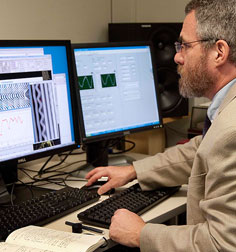
Recovering Sounds to Preserve the Past
The sounds you hear in this gallery are from rare experimental recordings made between 1881 and 1885. The records were considered unplayable until 2009.
The recovery of these sounds is the work of partners at Lawrence Berkeley National Laboratory—scientists Carl Haber and Earl Cornell—and the Library of Congress—digital preservation specialist Peter Alyea. They have employed a new system designed to permit recordings, even broken or damaged ones, to be digitally reassembled and revived. Over the past decade, IRENE has recovered sound from recordings in a number of collections and a wide range of record formats and conditions.
This work offers some hope in improving the dire state of collections of early sound recordings around the world. A vast amount of our cultural heritage has been captured on fragile or obsolete recording media, and, without preservation, the content is inaccessible and in danger of being lost forever.
Left to right: Peter Alyea, Library of Congress, Carl Haber and Earl Cornell, Lawrence Berkeley National Laboratory (Roy Kaltschmidt photo courtesy of Lawrence Berkeley National Laboratory)
Carl Haber’s notebook pages for June 19, 2012. On these pages are notes from the day the only known recording of Alexander Graham Bell’s voice, from April 15, 1885, was recovered.



